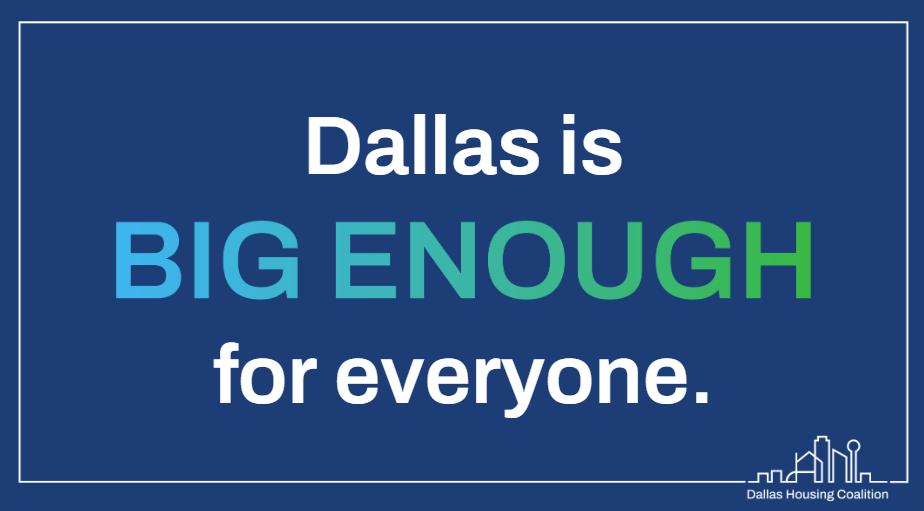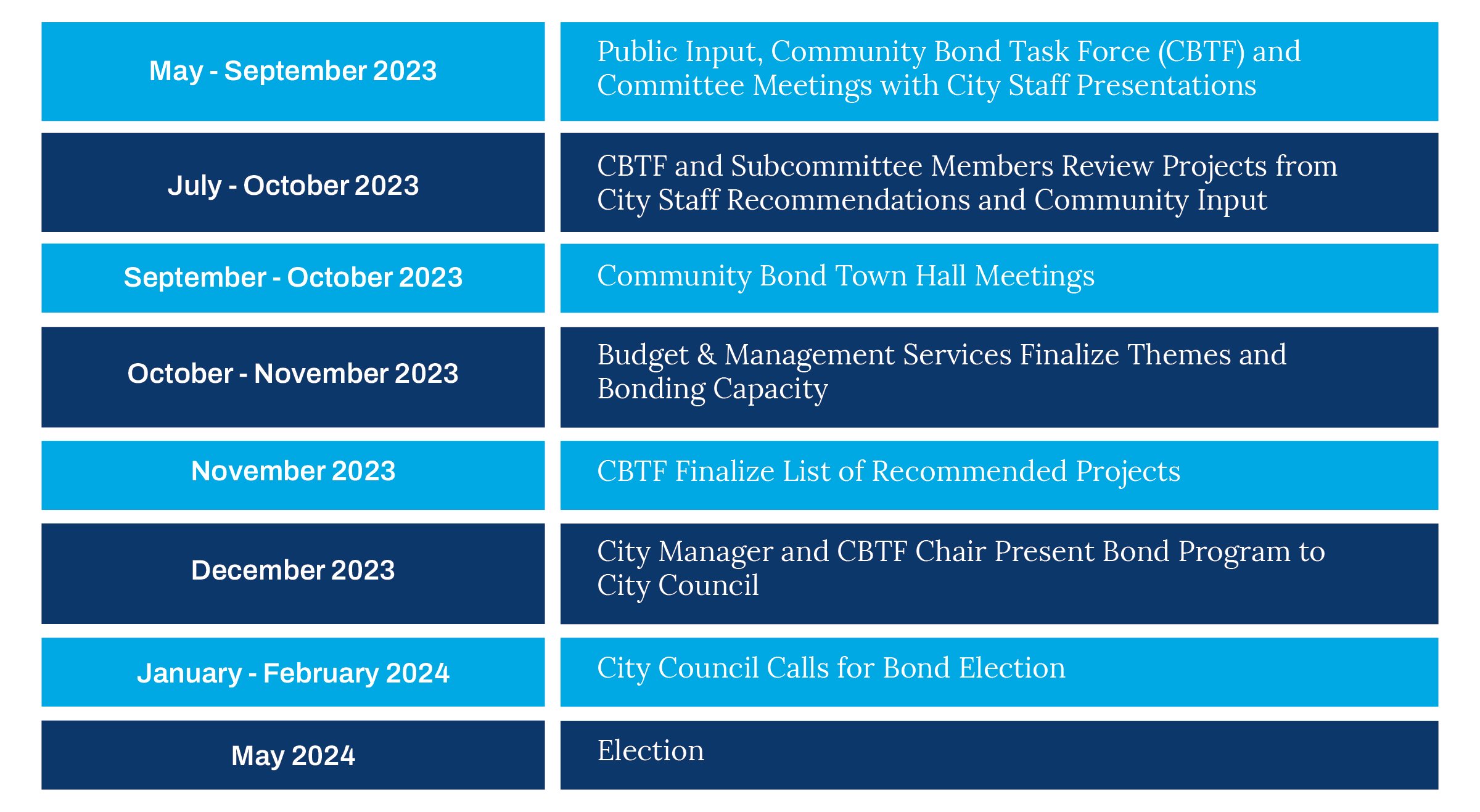
Frequently Asked Questions
Why is it necessary to support Proposition H ($26.4M for homeownership development)?
Providing attainable housing for our residents and workforce through Prop H is not only necessary but critical. Dallas has become increasingly unaffordable, causing people to move to surrounding cities to afford a home. Where people go, companies go, and that’s not good for the city of Dallas.
Will my property taxes go down if I vote against any of the bond propositions?
Voting against any of the bond propositions does not guarantee a decrease in the property tax rate. The Dallas City Council sets the tax rate every year and has lowered the tax rate for the last eight years. Building additional housing can help the City lower property tax rates in future years by increasing the tax base.
Why does Proposition H not identify specific projects?
It is impossible to identify projects in advance because bond dollars are often the “last-dollar in/subsidy” needed to fully fund a project and the development process takes time.
The City must also use a fair and equitable selection process to allocate this new, more flexible source of funding and selecting developers or specific projects in advance is neither fair or equitable.
If there are more than a dozen housing development tools at the City’s disposal that don’t require directly taxing our residents, why do we need bond funding?
Not all tools provide funding, and those that do still leave financing gaps for many potential projects.
If Propositions G, H, and I pass, thousands of affordable housing units can be built (source: Child Poverty Action Lab’s dallashousingcalculator.com).
Housing bonds by the City of Austin (2006, 2013, 2018, 2022) and San Antonio (2022) have been extremely successful in both producing units and leveraging other sources of funding.
Could the propositions supporting arts, libraries, economic development (housing) and homelessness be paid for out of the city’s general fund?
Unfortunately, the general fund leaves little funding for what these propositions support and is less equipped to make lasting capital investments. These issues are as necessary as streets and public safety. Dallas can’t wait. These issues need to be addressed now.
What is This 2024 Capital Bond Program I keep hearing about?
The City of Dallas is seeking voter approval of a Capital Bond Program totaling $1.25B in May. By selling and repaying general obligation bonds over time, cities rely on bond funding to address long-term needs including:
Streets and transportation
Parks and trails
Flood control and storm drainage
Critical facilities (such as public safety, libraries, cultural facilities, and city facilities)
Economic development, housing, and homeless solutions
Passing the 2024 Capital Bond Program does not increase the City's tax rate. Bond funds cannot be used for routine maintenance and operations.
What has the City of Dallas historically spent its bond funding on?
*Source: City of Dallas June 2023 Bond Input Town Hall Presentations
Note: The City of Dallas has spent over $3.5 billion using bonds over the last 20 years. Less than $5 million has been allocated to housing, and $0 was dedicated to Housing in 2012 and 2017. $6.3 million from Homelessness funding in 2017 (Proposition J) was later used for Housing-specific purposes, including:
$2M - Mill City Infill Development Project
$741,730 - Fair Park West Jeffries-Meyers
$1,427,000 - Jeffries-Meyers Infill Development Project
$800,000 - West Dallas Targeted Rehab Program
Why did the Dallas Housing Coalition advocate for $200 million for Housing in the 2024 Capital Bond Program?
A recent study by the Child Poverty Action Lab found that Dallas has a 33,600 unit supply gap in rental housing. Without action, this gap will grow to 83,500 units by 2030.
Further, according to buildingcommunityWORKSHOP’s State of Dallas Housing - 5 Year Comparison Report, there is a supply gap of over 60,000 for-sale units for families making between $35,000 and $100,000 annually who might wish to purchase a home.
At an average production cost of $200,000/unit, the current housing gap will take at least $10 Billion in total investment to close as a conservative estimate.
Research from previous housing bonds in Austin and San Antonio shows Dallas can expect a 1:10 leverage ratio with the private sector. The more the City of Dallas invests in housing now, the more effectively and efficiently the City can work with developers and other partners (DHA Housing Solutions for North Texas, i.e.) to achieve its housing, racial equity, land use, and economic development goals.
How would the $200 million for Housing have been spent if it were to be allocated by the City of Dallas for Housing?
Dallas City Staff and the Community Bond Task Force Subcommittee on Economic Development, Housing, and Homelessness recommended bond funding for housing for four purposes with specific household income targeting and $35M for homeless solutions:
Promote homeownership ($80M)
Improve infrastructure to support homeownership development
Provide gap financing to developers
Partner with other public entities such as DART, DHA, and Dallas ISD
Preserve affordable rental housing units ($40M)
Rehabilitate aging multifamily complexes
Provide gap financing to developers
Stabilize neighborhoods and combat displacement
Preserve affordable homeownership housing units ($10M)
Repair existing single-family homes
Provide gap financing to developers
Stabilize neighborhoods and combat displacement
Create more mixed-income and mixed-use communities, such as the Dallas International District, around UNT-Dallas, and in Pleasant Grove, and Equity Strategy Areas identified in the 2033 Dallas Housing Policy ($70M)
Invest in target catalytic investment areas
Leverage private investments
Grow tax base
Where could these funds be spent?
The City of Dallas recently adopted Dallas Housing Policy 2033 and identified equity strategy target areas. This process identified specific disparities in housing opportunities and reduce them utilizing targeted approaches most appropriate for the geographic area. Bond funds may be utilized citywide in high-opportunity areas and these equity strategy areas, such as to generate homeownership in Pleasant Grove and University Hills and preserve affordable housing in South Dallas and West Dallas where it is most needed. Mixed-income development could be created around DART stations and the International District, as a couple of additional examples.
Who benefits from these investments?
We all do! Increasing the housing supply increases Dallas’ tax base, which can be reinvested to provide higher levels of service to all residents, and slows down the rapidly rising cost of housing, including rental rates and home values. Further, bond dollars could be used to target households making less than Dallas’ Area Median Income (AMI), which is $89,000 for a household size of 4, who most need support.
Who oversees these investments and projects being funded for accountability and quality assurance over time?
There are several funding and control mechanisms in place through the City’s standing year-round Notice of Funding Availability (NOFA), Dallas Housing Finance Corporation (DHFC), Dallas Public Facility Corporation (DPFC), Dallas Housing Opportunity Fund (DHOF), and the Dallas City Council, which will give the final approval for all future, bond-funded projects and programs. The Dallas Housing Coalition also looks forward to acting as an accountability force for the efficient and equitable distribution of Housing/Homeless Solutions bond allocations and advocating for other policy/land use reforms that can be combined with bond investment to boost the development and preservation of attainable housing in Dallas for all.
What is the expected return on investment for the City of Dallas?
While it is difficult to forecast the economic impact of future projects, construction alone generates huge economic returns for the City. According to the most recent Development Services Economic Impact Report, the City of Dallas has generated over $2.7B from new single family, multifamily, and commercial construction since August 2022. The City of Dallas has also generated over $1.4B from the rehabilitation of existing single family, multifamily, and construction.
For comparison on the effectiveness of bond dollars dedicated towards housing specifically, we can look towards the City of Austin’s 2013 and 2018 Bond Programs. Research shows through 2021, general obligation bond funds totaling $138.6 million have enabled developers to leverage a further $900 million in investment funds to develop 43 projects with a total of 4,372 units, of which 3,707 are affordable to tenants earning 50% or less of median income and owners earning 80% or less.
Austin researchers noted their findings must be taken as conservative. For example, it is likely that many residents of these developments enjoy additional household savings for transportation and other services as a result of living in safe, clean, well-located housing. In addition, these units likely contribute to the strength of the local labor force by making it possible for residents to stay in the city and reach jobs throughout the region.
Despite the inclusion of only quantifiable impacts, the results are striking. Creating and renovating the units made possible by the 2013 and 2018 bonds has produced an economic impact of more than $1 billion in the City of Austin, with far more to come. On an ongoing basis, the operation and maintenance of these units produces a further $101 million in annual economic impact, and that impact will only grow as remaining bond funds are expended and leveraged to create additional units.
In San Antonio, the City of San Antonio's Neighborhood and Housing Services Department awarded $81 million to support 30 projects in creating and preserving over 4,800 homes. Funding leveraged other public resources from both City and County funding including the City Housing Bond, City HOME-ARP, Bexar Country HOME-ARP and Bexar County Coronavirus State and Local Fiscal Recovery Funds (SLRF) for a total of $808M with $709M in private investment. Bond and federal contributions per unit equaled $20,497, and the developer contribution per unit equaled $146,852.
The City of Dallas could reasonably expect high levels of return on its investment through a significant allocation of bond funding towards housing. We could reap benefits to Dallas’ job market, supply chain, workers’ earnings, household savings and spending, and a reduced reliance on public safety and other supportive services, such as our healthcare system.
How many units could the City of Dallas expect to produce with $150M in Housing Bond funding in 2024?
The adjacent production forecast presented by Housing and Neighborhood Revitalization Department staff on April 24, 2023 to the Housing and Homelessness Solutions Council Committee showed how Dallas is capable of producing over 10,000 units annually over the next ten years if given $150 million in bond funding in 2024 and 2029 - meeting a 100,000+ unit goal. That means the City could have gained almost 15,000 affordable units with a 2024 bond allocation of $150M, spurring another 32,000 in market rate units. This would meet both the deep affordability need we have in the City for folks at 50% AMI or lower and close the supply gap we have across all levels that are driving rental costs up.
What is the projected City of Dallas 2024 Capital Bond Program development timeline?
How can I get involved in supporting the passage of the City of Dallas 2024 Capital Bond Program?
Good news! You are in the right place. Simply scroll down to the bottom of this page to join our coalition or subscribe to our emails, and we will keep you updated on all upcoming advocacy opportunities!
Is there a membership fee for members to get involved with the Dallas Housing Coalition?
There are zero financial requirements for individuals and organizations to become members of the coalition!










